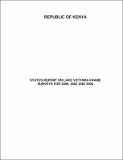| dc.description.abstract | Lake Victoria Frame Survey is a major activity under Statistical data collection systems of Fisheries Management Component of Lake Victoria Environment Management Program (LVEMP). It plays a vital role in the management of Lake Victoria Fisheries resources and supports various research activities. The survey is a complete census of crafts, gears, and fishers operating in the lake and all landing site facilities. Frame Surveys have been carried out in Lake Victoria from 1970 – 1998 but remained uncoordinated until the year 2000. At present, it is a biannual activity in the lake’s three riparian countries from the year 2000. In the year 2004, the survey was carried out between 27th and 30th April 2004 with reference to 27th April.
This activity has been coordinated and overseen by Frame Survey National Technical Committee (FS-NTC) and Frame Survey Regional Task Force (FS-RTF) at National and Regional levels respectively. The results in Kenya show that there were 304 fish landing sites compared to 306 in 2002 and 297 in 2000. The number of fishers was 37,348 operating 12,284 fishing crafts in 2004 as opposed to 38,431 and 54,163 fishers, and 11,515 and 12,209 fishing crafts in the years 2000 and 2002 respectively.
The number of gill nets has increased over the years from 130,708 in the year 2000 to 133,365 and 190,756 in the years 2002 and 2004 respectively. There were 2,045,605 long line hooks in the year 2004 compared to 1,039,893 and 2,562,066 in the years 2000 and 2002 respectively The number of beach seines was 869; about 24.9% and 80.1% reduction from the previous figures of 1,157 and 5803 in the years 2002 and 2000 respectively. Small seines (Mosquito seines) were 3,048 having increased from 2,097 in the year 2002 and this figure in year 2002 had decreased from 12,387 in the year 2000.
Twenty five percent (25%) of the landing sites had fish bandas while 22% were accessible by all weather roads. Electricity supply and potable water were found in 4% and 7% of the landing sites respectively. The proportion of landing sites with pontoon/jetty, toilets, and fish store were 4%, 58%, and 4% respectively. On average, one fisheries staff manned 8 fish landing sites.
With the current social and economic dependency on Lake Victoria resources, the ratio of staff to landing site should be matched to improve development and management efforts. Fish handling facilities and access to fish landing sites should be improved. The implication of the increases in fishing effort on the fish stocks should be assessed and appropriate measures taken. Specific and concerted efforts should be made to remove illegal sizes of gill nets and beach seines from the lake.
Adequate and timely availability of logistics is mandatory for effective implementation of such a survey. A committee that will be charged with coordination of future Frame Surveys should have better definition of their roles and empowered to execute the said roles without undue interferences.
This report presents detailed results of the survey. | en_US |

